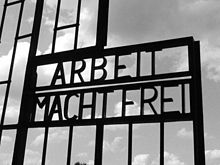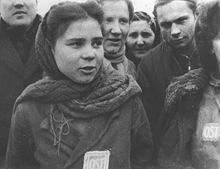- Deutsche Wirtschaftsbetriebe
-
Deutsche Wirtschaftsbetriebe (German Economic Enterprises), generally abbreviated DWB was a project launched by the Allgemeine SS to profit from the use of Nazi concentration camp inmates as slave labor.
Contents
Holding company for Nazi concerns
DWB was a holding company for more than 25 SS industries. Oswald Pohl, the head of the SS business department (known by its German initials as WVHA) was also the chief officer of DWB. Georg Lörner, another high WVHA official, was another incorporator.[1] Through stock ownership DWB controlled a wide variety of enterprises, such as stone quarries, brick manufacturing plants, cement mills, pharmaceutical factories, real estate, housing, building materials, book printing and binding, porcelain and ceramics, mineral water and fruit juices, furniture, foodstuffs, and textiles and leather.[2]
Role in war crimes
After World War II. the surviving chief officers of WVHA were placed on trial for crimes against humanity. Most of them were found guilty. Both Oswald Pohl and Georg Lörner were sentenced to death by hanging, although Georg Lörner managed to get his sentence commuted to a prison term. The war crimes tribunal placed particular emphasis on the role the defendants had played in four DWB subsidiaries:
- The German Earth And Stone Works (Deutsche Erd- und Steinwerke), known as DEST, which operated five granite quarries, six brick and tile plants, and a stone-cutting plant;
- The Klinker-Zement, manufacturing brick and cinder block, fireproof products, ceramics, lime, and chalk. This company had large subsidiaries at Golleschau, Prague, Lvov, and Bialystok;
- Ostindustrie, or OSTI, organized in March 1943 and dissolved a year later, which, using forced Jewish labor operated all confiscated Jewish industries in German-occupied Poland, including foundries, textile plants, quarries, glass works, and others.
- The German Equipment works (Deutsche Ausrüstungswerke) or DAW, which operated various industries in seven concentration camps, using forced inmate labor.[2]
DEST in particular became notorious for exploitation under brutal conditions of the labor of concentration camp inmates at Mauthausen-Gusen concentration camp in Austria.
Notes
- ^ Nuremberg Military Tribunal, "Judgment of the Tribunal (regarding Georg Lörner), 3 November 1947,", United States of America v. Oswald Pohl, et al. (Case No. 4, the "Pohl Trial), V, pp. 1004–1008, http://www.mazal.org/archive/nmt/05/NMT05-C001.htm
- ^ a b Nuremberg Military Tribunal, "Judgment of the Tribunal, 3 November 1947,", United States of America v. Oswald Pohl, et al. (Case No. 4, the "Pohl Trial), V, pp. 962, http://www.mazal.org/archive/nmt/05/NMT05-C001.htm
See also
- Oswald Pohl
- August Frank
- August Frank memorandum
- Pohl trial
Further reading
- Nicosia, Francis R., and Huener, Jonathan, Business and Industry in Nazi Germany, University of Vermont Center for Holocaust Studies Berghahn Books, 2004 ISBN 1571816542
- Sofsky, Wolfgang, The order of terror : the concentration camp, Princeton University Press, 1996 ISBN 069104354X
SS Branches Leadership - Reichsführer-SS
- SS and Police Leader
- SS personnel
- SS commands
Main departments - Office of the Reichsführer-SS
- Head Administrative Office
- Head Operational Office
- Reich Main Security Office (RSHA)
- Economics and Administration Office
- Office of Race and Settlement (RuSHA)
- Main Office for Ethnic Germans (VOMI)
- Office of the Reich Commissioner for Germanic Resettlement (RKFDV)
- Courts Office
- Personnel Office
- Education Office
Ideological institutions - Ahnenerbe
- Das Schwarze Korps
- SS-Junkerschule Bad Tölz
Police and security services Führer protection Paramilitary units - Einsatzgruppen
- Ypatingasis būrys
- Lithuanian Security Police
- Rollkommando Hamann
- Arajs Kommando
- Ukrainian Auxiliary Police
- Ukrainian collaboration
- Trawnikis
Waffen-SS divisions Foreign SS units - Germanic-SS
- Germaansche SS in Nederland
- Germaansche SS in Vlaanderen
- Germanske SS Norge
- Schalburg Corps
- Britisches Freikorps
- Europäische Freiwillige
- S.S. Sturmbrigade R.O.N.A.
- Finnisches Freiwilligen-Bataillon
SS-controlled enterprises - Ostindustrie
- Deutsche Wirtschaftsbetriebe
- Deutsche Ausrüstungswerke
- DEST
- Allach porcelain
- Apollinaris
- Mattoni
- Sudetenquell
Categories:- Nazi SS
- Unfree labor during World War II
- German words and phrases
Wikimedia Foundation. 2010.


